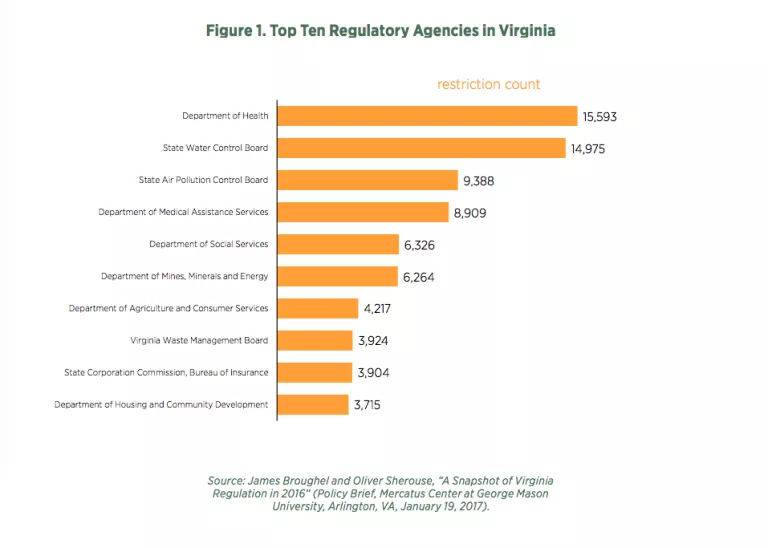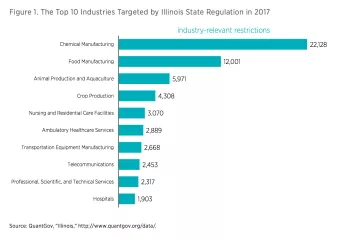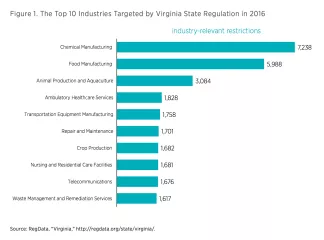- | Housing Housing
- | Policy Briefs Policy Briefs
- |
A Step-by-Step Guide to Using Mercatus Tools to Reduce State Regulation Levels
For states wishing to cut excessive “red tape,” that is, to reduce unnecessary regulatory burdens, designing a process to accomplish this goal can be a daunting task. This guide offers state policymakers a fairly simple and straightforward process for achieving this objective using tools developed by the Mercatus Center at George Mason University. Although the process outlined here is not the only path to reducing regulatory burdens, it has some advantages, including its relative simplicity, cost-effectiveness, and transparency. Some aspects of the approach have also been tested, and proven successful, in previous regulatory reform efforts.
Step 1: Define Regulatory Burden
The first order of business for states wishing to reduce their level of regulation is to determine precisely what they want to reduce. Regulatory burden can be measured in a number of ways. For example, it can be measured in terms of the number of pages in the state administrative code, the number of final rules published by agencies, or paperwork, compliance, or social costs that rules impose on the public.
There are merits and drawbacks to each of these approaches. Because resources tend to be limited in states, this guide recommends using a relatively simple metric: the total count of restrictive words (also known as “regulatory restrictions”) found in a state’s administrative code. Restrictive words include legal obligations and prohibitions on the public and are signified by words and phrases such as “shall,” “must,” “may not,” “prohibited,” and “required.” Resources permitting, policymakers who wish to develop a more comprehensive measure of regulatory burden could look beyond the state administrative code to agency notices, memoranda, guidance documents, and other agency releases.

Before a state decides how much regulation it wants to cut, it must first know how much regulation it has and decide whether that amount seems excessive. If regulation is defined as the number of restrictive words appearing in the state administrative code, then a baseline, or initial starting point, can be established using Mercatus’s State RegData tool, which is a computer program that scans bodies of state regulatory text and counts the number of restrictive words. When run through a state’s administrative code, State RegData can establish each of the following: the total number of restrictive words on the books at a given point in time, the growth in the number of restrictions across time (if the administrative code is available for multiple years), the industries most targeted by state regulation, and the regulatory agencies with the most restrictive words on the books. Figure 1 provides an example of how tallying restrictions according to the regulatory agencies that produce them is possible for a state like Virginia.
Step 3: Set a Target Reduction Goal and a Deadline
After establishing a baseline, the governor, state legislature, or some other body will set a goal for how much the code should be reduced. This will be largely a political decision, since it is difficult to know the “right” amount of regulation in any state. A 2013 survey of small businesses in the United States and Canada reported that respondents thought the burden of regulation could be reduced by about 30 percent without compromising the public interest. However, the perception of how much unnecessary regulation exists will vary by time and by place as well as across populations affected.
It may make sense to target a level of regulation close to levels found in similar or nearby states that are experiencing strong economic performance. One model to follow might be the Canadian province of British Columbia, which in 2001 set a goal of reducing its number of regulatory requirements (a metric similar to restrictive words) by one-third in three years. By 2004, 37 percent of regulatory requirements in British Columbia had been eliminated, and more have been eliminated in subsequent years. As of 2016, 47 percent of the regulatory requirements had been eliminated since 2001.
Rather than focus on the aggregate number of restrictive words found in the entire code, states may want to task different regulatory agencies with different reduction targets, since not every agency contributes to unnecessary regulatory burdens equally. Whatever target level and method of reduction policymakers choose, it is advisable to set a clear goal and a deadline for when the goal is to be met. Without clear objectives, reformers will have difficulty measuring the progress of their efforts, which could result in a lack of accountability and a lower probability of success.
Step 4: Create an Oversight Mechanism
Oversight over the red tape reduction process is needed and can come in many forms, and it does not have to be complicated or expensive to be effective. The body providing oversight can be an existing committee in the legislature or an office within the executive branch. A state may already have a body providing third-party review of regulations, which could be a logical place to house oversight functions since it presumably already possesses considerable expertise on state regulatory matters. Alternatively, if resources permit, a governor, via executive order, or the legislature, via statute, could set up a red tape reduction commission. The purpose of such a commission is to establish a process for reviewing the administrative code in a state, to ensure the successful and timely achievement of target goals, and to report back to the governor and the legislature regarding the progress of reform efforts.
The commission should also focus on communication with the public to ensure the benefits of regulatory reform, such as smarter and more efficient government, are well understood. The commission’s staff should comprise a diverse group of individuals representing multiple viewpoints, including the viewpoints of consumers, industry, and government officials. Possible models for a red tape reduction commission include the Base Realignment and Closure system that recommended federal military bases for closure and previous state red tape reduction commissions.
Step 5: Establish a Process to Review the Code and Get Buy-In from Regulators
The next step is to review the regulatory code itself to identify red tape for elimination or modification. Input from the public can be helpful in this task, but it is important to get feedback from as many sources as possible so as not to limit responses to a narrow range of interests. Public feedback can also result in unexpected reform ideas that fall outside the scope of reformers’ original plans. For example, during public hearings held as part of a 2010 New Jersey reform effort, members of the public complained about how prevailing wage requirements had raised the cost of public projects and prevented citizens from donating their services to their communities. Although this sort of information might not be what reformers intended to gather at public hearings, such information is nonetheless valuable.
As for the actual review of the state code, this could conceivably be the responsibility of a red tape reduction commission or a legislative committee; however, it is probably more practical and economical to have regulatory agencies review their own portfolios of rules. First, regulators will be more familiar with their own rules than most other parties will be, so there is less of a learning curve. Second, this may require no additional state resources since presumably regulators are already monitoring program effectiveness to varying degrees. Resources and priorities simply have to be reallocated from a focus on rule writing to a focus on rule improvement and management.
Regulators also possess valuable information, and it is important that they perceive they are part of the reform effort and don’t feel unfairly targeted with criticism. The risk of the latter is not negligible, since rules being eliminated are ones that regulators promulgated. If regulators are not invested in the reform, it is likely to fail. To enlist agency assistance and obtain agency buy-in, the oversight body may want to direct each agency to reduce its own restrictions by a predetermined amount and then give agencies wide latitude to decide how best to accomplish this goal. A formal policy requiring agencies to remove multiple old restrictions for every new one introduced is a way of motivating agencies to reduce regulatory burdens—by changing their incentives—while also giving regulators the flexibility to decide which requirements should stay and which should go. Such a policy is known as a regulatory budget. At first, the budget should be established to reduce regulation levels, but over time budget allowances might evolve toward keeping regulation levels constant or possibly growing at a certain rate.
If an agency is responsible for reducing its own regulatory burdens, the job of the oversight body will be primarily to check in with agencies periodically to make sure the effort is on track. With a clear metric to measure success, it will be fairly easy to determine whether regulatory agencies are succeeding. The oversight body can then focus on public relations, writing evaluative reports, and making recommendations to the state legislature (for example, when statutory action is needed to make regulatory changes).
Step 6: Institutionalize a Regulatory Budget
Once a state has succeeded in reducing its level of regulation to the desired level, maintaining the reduction should be a priority. There is a natural tendency for the level of regulation to rise over time—a phenomenon known as regulatory accumulation. This is true in part because regulators are typically rewarded for issuing regulations, but not rewarded for withholding or eliminating regulations. Therefore, once the code has been streamlined, it makes sense to encourage a permanent culture change at agencies to prevent regulatory accumulation from recurring.
A regulatory budget is one such means to control the amount of regulation that can be issued and to change the culture at agencies. After its initial goal had been met, British Columbia institutionalized a form of regulatory budget that ensures that the level of regulation stays roughly constant (as measured by the number of regulatory requirements) over time. States that want more flexibility might allow the regulatory code to grow over time, but only at a specified rate.
The key question will again be how to define the cap on regulatory burdens for the purpose of implementing a regulatory budget. Policymakers could frame the budget in terms of compliance or social costs that agencies may impose on the public or, to keep things simple, could again limit the total number of restrictive words each agency or all agencies may have on the books at any one time. The latter form of budget may prove easier to implement and enforce, because estimating costs can be time consuming and expensive. Cost analysis is also prone to gamesmanship by agencies, which can use their expert knowledge of an issue to over- or underestimate costs in economic analysis. To guard against such manipulation, there needs to be third-party oversight over agency economic analyses, which is itself costly. In contrast, a count of restrictive words is easy to calculate and difficult to manipulate.
Table 1: Steps to Reduce Regulation Levels in a State
| Step 1 | Define regulatory burden |
|---|---|
| Step 2 | Establish a baseline |
| Step 3 | Set a target reduction goal and deadline |
| Step 4 | Create an oversight mechanism |
| Step 5 | Establish a process to review the code and get buy-in from regulators |
| Step 6 | Institutionalize a regulatory budget |
Conclusion
The process outlined here is one way a state might go about reducing, and maintaining the reduction of, regulation levels. It is far from the only way. However, if any of the steps presented here are missing, there is a likely chance that the goals of reform efforts will not be met. Furthermore, there are several reasons to think the process described here is likely to be effective. First, it is simple. Setting a target reduction in the number of regulatory restrictions in a state’s administrative code is straightforward, easy to monitor and assess, relatively inexpensive (given limited state resources), and difficult to manipulate. Second, similar reform efforts have been successful in the past, most notably in the Canadian province of British Columbia. Finally, analytic tools, such as State RegData from the Mercatus Center at George Mason University, are available to assist in this type of regulatory reform effort.



